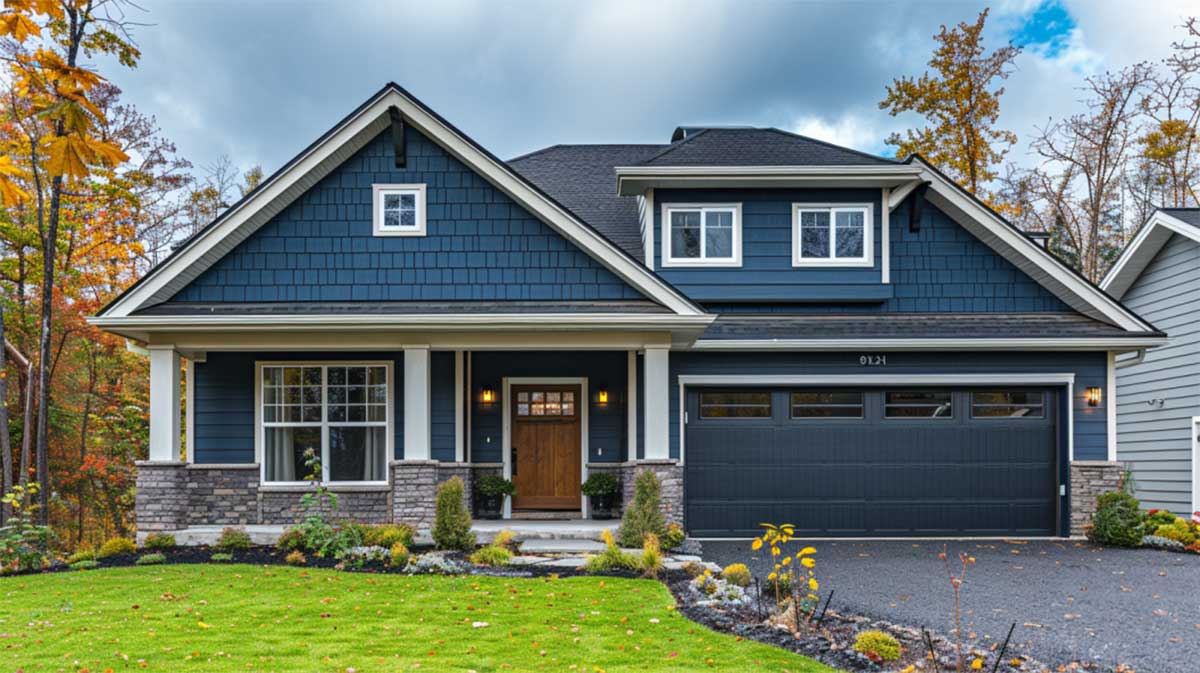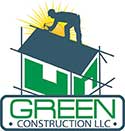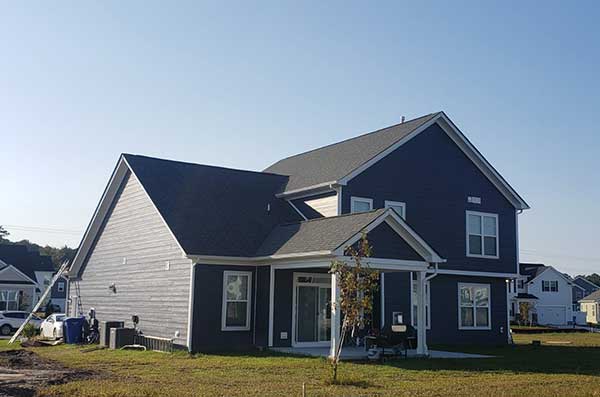Garage Door Replacement
When considering home remodeling projects, garage door replacement emerges as a surprisingly lucrative investment. With an average cost of $4,513, this upgrade can yield an impressive resale value of $8,751, resulting in a remarkable return on investment (ROI) of 193.9%. This ROI has seen a substantial increase of 91.2% from the previous year, highlighting its growing significance in home renovations.
Upgrading to a new garage door significantly improves curb appeal, a vital factor in attracting potential buyers and expediting the sale process. Modern garage doors are available in various styles and materials, allowing homeowners to choose options that best complement their home’s aesthetic while boosting functionality.
Beyond increasing property value, investing in a garage door replacement offers energy efficiency benefits, as newer models often provide better insulation. This dual advantage of improved appearance and performance makes garage door replacement a wise choice for homeowners looking to maximize their investment.
The high ROI and multifaceted benefits of garage door replacement position it as a top contender among exterior home remodeling projects. As property owners seek cost-effective ways to increase their home’s value, this relatively simple upgrade offers substantial returns and immediate visual impact.
Entry Door Upgrades
Entry door upgrades stand as another highly profitable home improvement option, rivaling the impressive returns of garage door replacements. Homeowners seeking to boost their property’s value and curb appeal should consider investing in new entry doors, given their remarkable ROI potential. Steel entry doors, with an average cost of $2,355, offer an astounding 188.1% ROI, recouping more than the initial investment upon resale. For those desiring a more luxurious option, fiberglass grand entrance doors provide a 97.4% ROI, with an average cost of $11,353 and a resale value of $11,054.
Beyond financial returns, entry door upgrades significantly improve a home’s aesthetic appeal, creating a strong first impression for potential buyers. Energy-efficient doors contribute to improved insulation, leading to lower energy bills and increased market appeal. The quick installation process allows homeowners to enjoy immediate benefits while improving overall home security. When considering exterior remodeling projects, entry door replacements emerge as a high-value option, combining aesthetic improvements with practical advantages. By carefully selecting materials and styles, homeowners can maximize their investment, potentially recouping more than the project’s cost while elevating their property’s overall value and appeal.
Siding Renovation

A home’s exterior armor, siding renovation stands as an vital investment for homeowners seeking to improve both aesthetics and functionality. This high-impact remodeling project not only elevates curb appeal but also boosts energy efficiency and overall property value. Homeowners can expect to invest between $3,000 and $15,000 for siding renovations, depending on material choice and home size.
| Material | Average Cost | ROI |
|---|---|---|
| Fiber-cement | $20,619 | 88.4% |
| Vinyl | $17,410 | 80.2% |
| Other options | Varies | Varies |
Fiber-cement siding offers the highest return on investment, recouping approximately 88.4% of its value at resale. While more expensive initially, its durability and aesthetic appeal make it an attractive option for homeowners focused on long-term value. Vinyl siding, though less costly, still provides a substantial 80.2% ROI.
Replacing old siding not only improves a home’s exterior appearance but also protects against weather damage, making the property more appealing to potential buyers. As a vital element in maintaining a home’s structural integrity, siding renovation proves to be a wise investment for homeowners looking to maximize their property’s resale value while enjoying improved energy efficiency and curb appeal.
Deck and Patio Additions
Moving from exterior siding to outdoor living spaces, deck and patio additions represent another significant home improvement opportunity. These projects offer homeowners a compelling return on investment (ROI) while improving their property’s functionality and appeal. Deck additions typically recoup 70-83% of their initial cost, making them a financially sound decision for those looking to boost property value.
Wooden decks provide an average ROI of 83%, while composite decks can yield up to 90% return due to their durability and low maintenance requirements. The cost for deck or patio additions ranges from $17,000 to $25,000, varying based on materials and design choices. This investment not only improves curb appeal but also creates functional outdoor spaces that attract potential buyers in markets where outdoor entertaining is popular.
Properly designed and constructed deck additions significantly improve a home’s overall appeal. By expanding outdoor living spaces, homeowners can create versatile areas for relaxation and entertainment. These improvements are particularly valuable in regions where climate allows for extended outdoor use. As home improvement projects go, deck and patio additions offer a balanced combination of immediate enjoyment and long-term financial benefits, making them an attractive option for homeowners seeking to maximize their property’s value.
Landscaping Enhancements
Landscaping improvements represent a high-impact, cost-effective approach to increasing a home’s value and curb appeal. With the potential to boost property value by up to 10%, strategic landscaping upgrades offer an excellent return on investment for homeowners. Simple improvements, such as planting trees, adding flower beds, or maintaining lawns, typically range from $2,000 to $5,000, making them accessible to many homeowners.
Well-designed landscaping plays an essential role in creating positive first impressions, significantly influencing buyer interest and potentially leading to quicker sales. By incorporating native plants, homeowners can reduce maintenance costs while appealing to eco-conscious buyers, further increasing property value. Strategic landscaping elements, including pathways and outdoor lighting, create inviting outdoor spaces that effectively extend livable areas and improve overall aesthetic appeal.
To maximize the impact of landscaping upgrades, homeowners should focus on creating a cohesive design that complements the home’s architecture and surrounding environment. By carefully selecting plants, hardscaping materials, and lighting fixtures, homeowners can create a visually appealing and functional outdoor space that not only increases property value but also improves the overall quality of life for current residents.
Window Replacements
While exterior improvements boost curb appeal, window replacements offer both aesthetic and functional benefits to homeowners. These upgrades significantly improve a home’s energy efficiency, with vinyl windows recouping 67.1% of costs and wood windows recovering 62.9%. The investment in window replacements aligns with current market trends favoring energy-efficient upgrades, contributing to increased marketability and potentially higher resale values.
Low-E glass windows, in particular, are gaining popularity for their energy-saving capabilities. These features appeal to eco-conscious buyers and can lead to reduced utility costs, making the property more attractive in a competitive real estate market. The overall impact of window replacements extends beyond immediate cost savings:
- Improved curb appeal, enhancing the home’s overall aesthetic
- Increased energy efficiency, resulting in long-term utility cost reductions
- Improved marketability, attracting environmentally conscious buyers
When considering window replacements as part of a home remodeling strategy, homeowners should weigh the initial investment against potential returns. With vinyl windows costing an average of $21,264 and wood windows at $25,799, the choice of materials can significantly impact the project’s cost-effectiveness. Ultimately, window replacements represent a valuable investment in both the home’s immediate comfort and its long-term value proposition.
Roofing Improvements
When considering roofing improvements, homeowners often weigh the merits of asphalt versus metal options, each offering distinct advantages in durability, cost, and aesthetics. Energy-efficient shingle upgrades present an opportunity to improve a home’s thermal performance while potentially qualifying for tax incentives or rebates. These roofing choices not only impact the immediate curb appeal and functionality of a home but also play a significant role in long-term energy savings and property value.
Asphalt vs. Metal Options
The choice between asphalt shingles and metal roofing presents homeowners with a significant decision in their roofing improvements. Asphalt shingles, the most common roofing material, offer an average cost of $30,680 with a 56.9% cost recouped. Metal roofing, while more expensive initially at $35,000 to $45,000, provides superior durability and longevity, lasting 40-70 years compared to asphalt’s 15-30 years.
Energy efficiency is increasingly prioritized by homebuyers, and metal roofing excels in this area. It can reflect heat, potentially reducing cooling costs by 10-25% compared to standard asphalt roofs. Additionally, metal roofing can increase home resale value by up to 6%, appealing to buyers seeking durability and sustainability.
When considering roofing options, homeowners should weigh:
- Initial cost vs. long-term value
- Energy efficiency and potential utility savings
- Impact on property value and resale potential
While asphalt shingles dominate the market due to affordability, metal roofing’s longevity and energy efficiency can result in a lower total cost of ownership over time. This makes metal roofing a compelling option for homeowners focused on long-term value and sustainability in their exterior home remodeling projects.
Energy-Efficient Shingle Upgrades
Energy-efficient shingle upgrades represent a significant advancement in roofing technology, offering homeowners a dual benefit of improved home comfort and potential energy savings. These modern roofing options, particularly fiberglass asphalt shingles, can improve a home’s energy efficiency while providing a cost recoup of approximately 56.9% upon resale. Homeowners considering a roof replacement can expect to invest between $20,000 and $30,000, depending on materials and installation complexity.
| Feature | Benefit | Impact |
|---|---|---|
| Reflective coatings | Reduced heat absorption | Lower cooling costs |
| Energy-efficient materials | Improved insulation | Enhanced home comfort |
| Sustainable design | Eco-friendly appeal | Increased property value |
The advantages of energy-efficient roofing extend beyond immediate utility cost reductions. These upgrades align with growing buyer preferences for sustainable home improvements, making properties more appealing in the real estate market. By incorporating reflective coatings, energy-efficient shingles help minimize heat absorption, leading to decreased cooling expenses during warmer months. This combination of improved energy efficiency, reduced utility costs, and enhanced home comfort contributes to a compelling value proposition for homeowners looking to boost their property value through strategic exterior renovations.
Exterior Lighting Upgrades
Upgrading exterior lighting serves as a powerful tool for homeowners looking to improve their property’s value and appeal. Strategic improvements to outdoor illumination can significantly boost curb appeal, potentially increasing a home’s value by up to 10%. By investing in energy-efficient LED options, homeowners not only reduce electricity costs but also attract eco-conscious buyers, further increasing resale value.
Well-planned exterior lighting offers multiple benefits that appeal to potential homebuyers:
- Improved safety and security, addressing a top priority for many purchasers
- Enhanced aesthetic appeal, highlighting architectural features and landscaping
- Integration of modern conveniences through smart lighting systems
Incorporating smart lighting technology allows homeowners to control outdoor illumination via mobile devices, appealing to tech-savvy buyers and adding a touch of sophistication to the property. Additionally, thoughtfully placed landscape lighting can accentuate a home’s best features, creating an inviting atmosphere that may lead to quicker sales.
Frequently Asked Questions
Which Exterior Renovation Adds the Most Value to a House?
Exterior renovations significantly impact a home’s value, with garage doors offering the highest return on investment. Entryway improvements, such as replacing steel entry doors, also yield substantial returns. Adding manufactured stone veneer and siding replacement contribute to improved curb appeal and energy efficiency. While landscaping upgrades, outdoor lighting, window replacement, deck additions, and roof improvements can elevate property value, their impact varies. Prioritizing these projects based on their potential ROI can maximize a home’s market appeal and overall value.
What Is the Best Renovation to Increase the Value of Your House?
The best renovation to increase home value typically varies based on market conditions and individual property characteristics. However, high-impact projects often include kitchen upgrades, which can significantly elevate resale value. Other value-adding renovations include landscaping improvements for improved curb appeal, energy-efficient upgrades, and outdoor living spaces. Garage door replacements, siding upgrades, and roofing improvements also offer strong returns. Additionally, deck additions and window replacements can contribute to heightened property value while improving functionality and aesthetics.
What Is the 30% Rule for Home Renovation?
Picture a homeowner standing at the threshold of transformation, calculator in hand. The 30% Rule for home renovation is a strategic planning approach that limits renovation budgets to 30% of a home’s current value. This guideline aids in value assessment, ensuring home upgrades align with market trends. By balancing cost vs. value, homeowners can maximize ROI and potential equity increase. This rule serves as a compass for investment priorities, guiding renovation decisions that improve property worth without overextending financially in volatile real estate landscapes.
What Raises Property Value the Most?
Improving curb appeal significantly raises property value. Landscaping upgrades, outdoor lighting, and entryway improvements create a strong first impression. Energy efficiency enhancements, such as roof replacement and upgraded siding materials, increase long-term value. Driveway paving, patio additions, and fence installation expand usable outdoor space, attracting potential buyers. These exterior renovations not only improve aesthetics but also functionality, making the property more desirable in the real estate market. Prioritizing these improvements can yield substantial returns on investment when selling a home.


1 comment
Types Of House Siding: A Comprehensive Guide » Green Construction Services
November 27, 2024